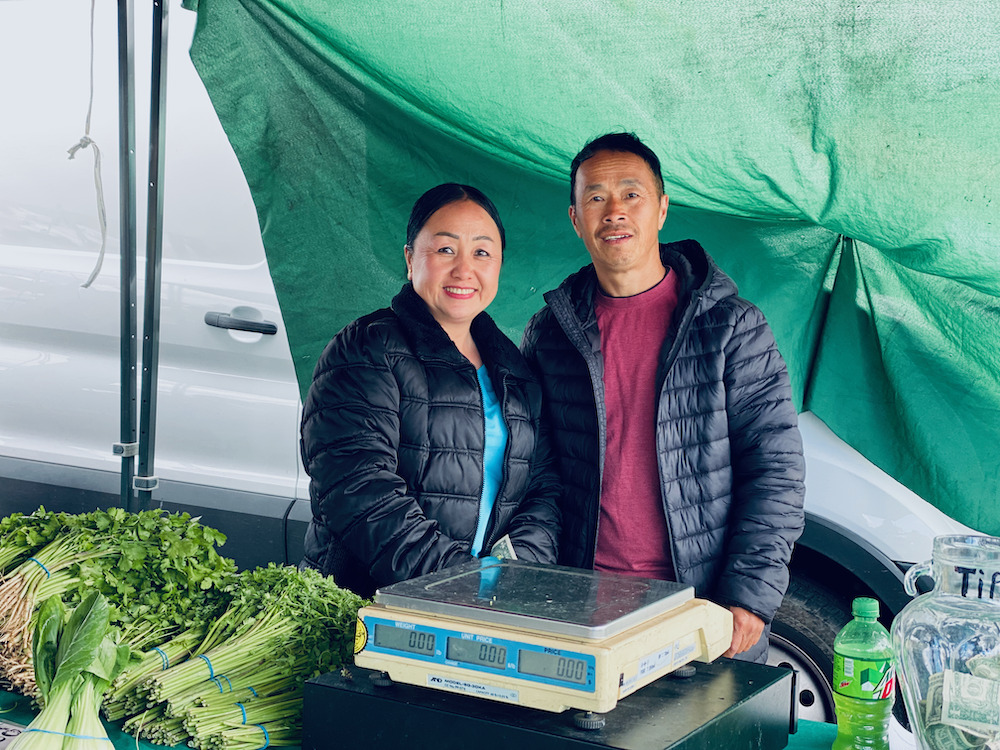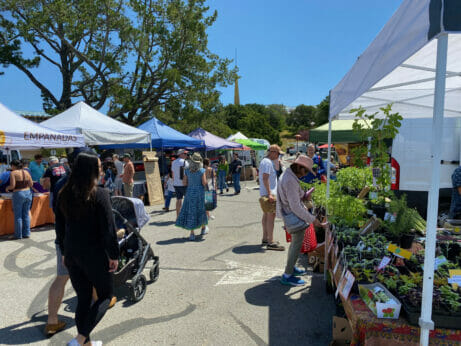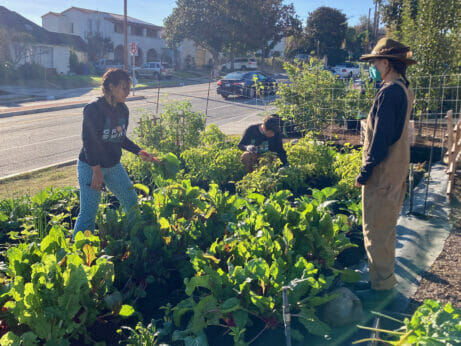A new bill aims to help the state’s independent farmers by first labeling who they are.

Despite offices being closed, Sundays are the busiest day of the week at the Marin County Civic Center. Located half an hour north of San Francisco—and within a couple of hundred miles of California’s many agricultural regions, including the Sacramento and San Joaquin valleys and the North and Central coasts—the Sunday Marin Farmers Market is the third largest among the state’s 655 open-air greenmarkets.
On busy weekends, crowds of locavores routinely swell to 15,000. “Customers come from all over,” says Gha Xiong, owner of Xiong Farm. He’s one of nearly 150 regional farmers, ranchers and food purveyors who set up Sunday shop in the sprawling parking lot, in clear view of the Prairie-style dome and spire designed by Frank Lloyd Wright.
For nearly two decades, Xiong and his wife, Kou Yang, have made the weekly, three-hour trek from their family farm outside of Fresno, where they grow a diverse range of Hmong and Asian produce such as bitter melon, bok choy and daikon. While business is normally brisk, an overly wet and drawn-out winter drowned their low-lying fields and delayed spring planting by nearly six weeks. Consequently, recent offerings have been slim. “People say, ‘You sold out so early today.’ No, [it’s just that] we don’t have enough to fill our tables,” he says, gesturing to the thinning pile of greens.

The Sunday Marin Farmers Market is the third largest in California. (Photo: Naoki Nitta/Modern Farmer)
For California farmers, relentless precipitation and a late spring are just the latest in a mounting list of challenges exacerbated by extreme climate, spiraling costs and increased environmental regulations. But the pressures exact a larger toll on independent producers like Xiong, many of whom lack the resources of the industrial giants that dominate the landscape. As a result, the state loses an average of four small-scale farms every day.
The recently proposed California Local Food Producers Bill (AB 1197) aims to stop the hemorrhaging by giving independently owned farms an official state designation and better support those who grow food for their communities. Although the bill isn’t directly tied to funding or other assistance, proponents say the legal definition would help target resources, state programs and future policies to help bolster the local food economy.
Small-scale producers play a vital role in supplying not just farmers markets but restaurants, community-supported agriculture (CSA) programs and food hubs, says Jamie Fanous, policy director at Community Alliance with Family Farmers (CAFF), a California-based, non-profit advocacy group and a major bill sponsor. “This is a path to designate who they are, so we can figure out how to protect those facing the highest pressures.”
A top-heavy landscape
The bill assigns values to “Local Food Producers,” defining them as independently owned farms in California that operate on less than 500 acres and sell more than 75 percent of products to their local community. (“Local,” however, remains a less-precise category, extending to the whole state.) The California Cattlemen’s Association, a non-profit trade group representing the state’s beef and dairy interests, has opposed the acreage limit, citing greater land needs for grazing cattle. In response, Assemblymember Gary Hart (D), who introduced the bill, is working to create a separate threshold to accommodate ranchers. “I am confident we will find the common ground to earn [their] support,” he told Modern Farmer in an email.
According to the 2017 Census of Agriculture, farms measuring less than 500 acres make up the backbone of U.S. agriculture, accounting for 85 percent of the overall landscape. Although that number inches up to 90 percent in California, two-thirds of its growers operate on less than 50 acres, helping to make the country’s biggest food producer also its most diverse.
Yet the largest five percent of properties make up more than half of the Golden State’s nearly 25 million acres of cropland, while 37 percent of fields and pastures are leased out by non-farmers. “So there’s a pretty significant power imbalance, where the majority of land is really owned by a few [parties],” says Fanous.
That shifts the foundations of California’s agricultural system away from individual and family growers to large companies and absentee landlords, many with weak ties to the local community. Often backed by speculative investment and run by farm management companies, she adds that these deep-pocketed operations are better equipped to weather the challenges of farming.
California faces a particularly unique set of issues that heighten the impacts. Like the rest of the nation, the state contends with extreme weather and temperatures, pest infestations and decreased crop resilience. “But our farmers are constantly dealing with the whiplash of drought, wildfires and floods,” says Fanous. “It seems like every two to three months, there’s something new.”
Additionally, development pressure gobbles up 50,000 acres of cropland every year. And for independent growers, the majority of whom lease their fields, skyrocketing land prices continue to take a larger bite out of their profit margins; Xiong, the Fresno farmer, reports that the rent on his five-acre farm has nearly tripled in the last decade.
“And we only anticipate things to get worse as a result of the Sustainable Groundwater Management Act,” adds Fanous, referencing California’s strict limits on pumping groundwater. Enacted to replenish the state’s overtapped basins, research shows that the regulations could end up fallowing as much as 900,000 acres of farmland along the way.
Many small-scale growers—immigrants and historically underrepresented groups in particular—lack robust safety nets, says Fanous. Only eight percent of California farms receive public subsidies, few carry crop insurance and government aid is often laden with paperwork, bureaucracy and delayed payouts. That leaves them highly vulnerable to consolidation, which, she notes, has ramped up in recent years, further tipping the balance of power in favor of big industry.
Labels matter
“It often feels like we go from one [crowdfunding] to another, just so we can keep farmers in California,” says Andy Naja-Riese, chief executive director of the Agricultural Institute of Marin (AIM). The non-profit operates nine farmers markets throughout the San Francisco Bay Area, including its flagship at the Marin County Civic Center, drawing more than 350 farmers, food purveyors and artisans from 40 California counties. They also serve 47,000 shoppers who use CalFresh—California’s version of Supplemental Nutrition Assistance Program (SNAP)—annually.
A recent survey reveals that this past winter’s storms hit AIM vendors hard: More than 75 percent missed market days, with a quarter experiencing property damage and 40 percent losing inventory. “The majority of producers rely on the markets and other local sales outlets to make their living,” says Naja-Riese. With many operating on razor-thin margins, “missed days and delayed sales have a huge impact on their business.”

Crop Swap LA operates three micro farms located in residential yards. (Photo courtesy Crop Swap LA)
In the past decade, California has seen nearly a fifth of its farmers markets and a third of its certified producers vanish. Giving local producers a legal designation is a key step in reversing the trend, says Fanous. “In order to protect a community, you need to first define [them], then map them to know where they are.”
The Farmer Equity Act, for instance, set the foundation for promoting equitable agricultural policies by identifying socially disadvantaged groups. Similarly, a local food producer designation allows effective inclusion or exclusion in measures such as water restrictions, grant and relief programs and technical resources, adds Fanous. “We could utilize this definition to exempt these producers from X, or prioritize for Y when it comes to, say, water or land issues.”
The label is every bit as relevant to urban growers and their communities, says Jamiah Hargins, executive director of Crop Swap LA, another bill supporter. The South Los Angeles-based CSA operates three micro farms located on slivers of residential yards. At just over one acre, Crop Swap LA grows a range of produce such as leafy greens, tomatoes and okra and distributes them weekly to 70 families within a tight, one-mile radius. The hyper-local system, says Hargins, ensures subscribers—many from underserved communities of color—with direct and reliable access to fresh, affordable and sustainably grown food.
Urban farms are an important investment in not just food security but community well-being and the local economy, says Hargins. “But in a city like LA, [real estate] is a money game,” he says, of the relentless threat that development poses to their existence. “So, hopefully, the bill will create a solid structure that helps us hold onto and guarantee our gains.”
While California grows most of the country’s produce, “the whole food system is set up to support industrial agriculture,” adds AIM’s Naja-Riese. “We can create better standards for what it means to feed your local community and put some meaning behind that.”